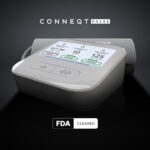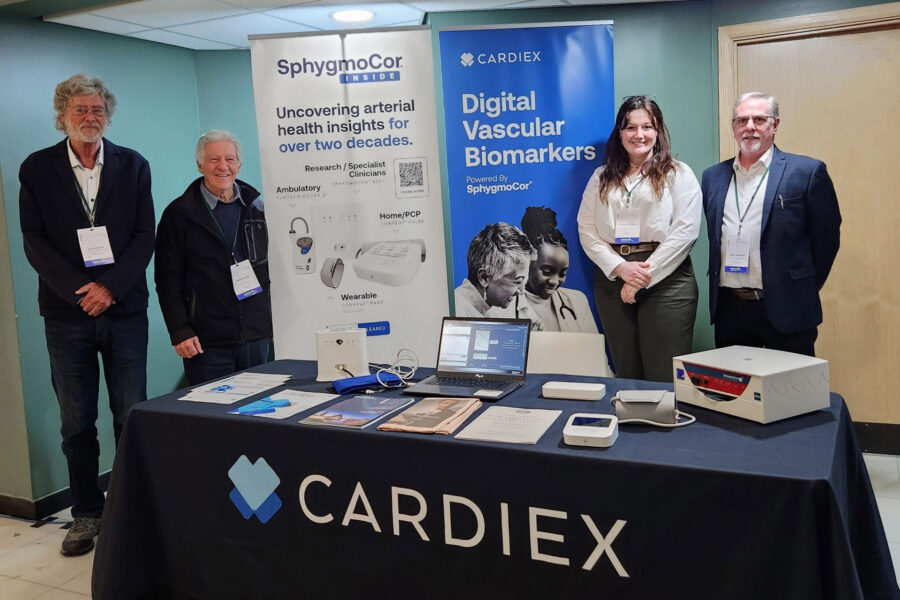
What is Subendocardial Viability Ratio (SEVR)?
January 13, 2023
FDA Grants 510(k) Clearance for the CONNEQT Pulse, a World-First Vascular Biometric Health Monitor
April 21, 2023Arterial Stiffness: A Complete Overview
Studies show rigid arteries are closely associated with cardiovascular disease, type 2 diabetes, Alzheimer’s, and other chronic diseases. Here’s how digital vascular biomarkers can help detect this dangerous cardiovascular warning sign.
The late Canadian physician William Osler, who has been described as one of the “greatest diagnosticians ever to wield a stethoscope,” famously quipped, “Man is only as old as his arteries.” In addition to the hazards of plaque and atherosclerosis, Dr. Osler may well have been talking about a less well-known condition, arterial stiffness, a key biomarker that predicts cardiovascular and other chronic diseases.
While clinicians typically measure brachial blood pressure and cholesterol, neither of these measurements show what is going in the large arteries closest to the heart, where it matters most. “Hard arteries are a canary in the coal mine of arterial health, an early biomarker that may help clinicians and researchers predict [and hopefully prevent] heart attack, stroke, heart disease and other chronic degenerative diseases,” says Raymond Townsend, M.D., Director of Hypertension at the University of Pennsylvania School of Medicine.
The good news: “Using non-invasive measures, researchers can predict how rigid vessels are by measuring how fast a pulse wave travels through the vascular system,” explains Dr. Norman Chideckel, a NYC-based vascular surgeon affiliated with Mount Sinai. The higher the number, the stiffer the artery, and the more likely a patient will be to experience heart attack, heart failure or stroke.
What Is Arterial Stiffness?
The walls of large arteries, especially the aorta, lose elasticity over time, as elastin degrades and is replaced by rigid collagen fibers in the arterial wall, Townsend explains. “This stiffening of blood vessels is a normal part of the aging process. Your body stops making elastin in puberty and then it has to last the rest of your lifetime.”
The Framingham Heart Study showed patients with increased arterial stiffness were 48% more likely to develop cardiovascular disease. And loss of elasticity in the arteries predicts future risk of Type 2 diabetes than blood pressure alone, according to a study recently published in Hypertension, a journal of the American Heart Association.
Arterial stiffness has also been associated with the development of cerebral small vessel disease and amyloid plaques, two important biomarkers for Alzheimers.
Researchers measure arterial stiffness using pulse wave analysis, which can tell them how fast blood pressure waves are moving down the vessel, Dr. Townsend says. “The stiffer the vessel, the faster the blood moves.”
How Stiff Arteries Affect Circulation
With each beat, the heart pushes blood out to the arteries (systole) and then relaxes or closes (diastole) as the blood comes back from the peripheral tissues, Joseph Raffaele, M.D., says. “Now imagine what happens when the tube-like balloon that is a healthy aorta is replaced by a metal pipe. That is what arterial stiffness is like.”
“A healthy aorta doesn’t just pump out blood, it also functions like a cushion, slowing blood down as the pulse waves bounces around within elastic arterial walls,” Dr. Raffaele says. “If the walls of the aorta become rigid, this cushioning disappears, causing the blood to move more quickly through the arteries [which leads to an increased pulse-wave velocity].”
And when this high pulse wave of blood reaches the fragile capillaries, it hits a wall, Dr. Raffaele explains. Some of the blood gets through, but some of the reflected pulse waves are returned to the heart too quickly while that organ is still trying to pump blood out (the systole phase), says Dr. Raffaele. This causes increased pulse pressure near the heart, which puts an enormous strain on this organ.
A fast pulse wave can also damage the delicate capillaries, Dr. Raffaele explains. “As you get older, your body produces less nitric oxide which forces these tiny vessels to contract. And when the capillaries become smaller and more damaged, less blood is able to reach key organs, like the kidneys and the brain.”
What Causes Arterial Stiffness?
Dr. Raffaele says there are many variables that may contribute to arterial stiffening, including a sedentary lifestyle, obesity, a high fat/high sugar diet, smoking, excess alcohol, stress, and various deficiencies (most notably of vitamins B and D). These negative lifestyle factors increase oxidative stress in the body, triggering inflammation which then torches pliant elastin in the arteries, replacing it with rigid collagen, explains Dr. Townsend. “It’s like the arterial walls are being replaced with scar tissue.”
In a clinical trial setting, measuring central blood pressure and related biomarkers like augmentation index can help researchers detect whether or not a drug or other therapeutic protocol is working and/or causing unwanted side effects.
How Measuring Central Blood Pressure Can Help
Atcor’s SphygmoCor® Xcel device measures key digital vascular biomarkers like central blood pressure and augmentation pressure, allowing clinical researchers to more accurately predict cardiovascular risk than they can using traditional blood pressure measurements alone.
Unlike standard brachial BP, which only measures pressure at the brachial artery, central blood pressure uses pulse wave analysis to estimate how arterial stiffness affects the pressure of blood coming out of the aorta, Dr. Townsend explains.
“Measuring central aortic blood pressure and other key markers such as augmentation pressure gives you a more accurate and complete picture of what’s really going on where it matters most: near the heart, he says. “Let’s face it: No one ever dies of an arm attack.”
In addition to helping doctors assess and manage hypertension in a clinical setting, the Xcel can maximize the potential for success in decentralized trials. By incorporating digital vascular biomarkers into each phase of the trial process, from patient recruitment to approval, researchers can improve diversity, safety, and efficiency. This enhances the likelihood of both regulatory and commercial success.




